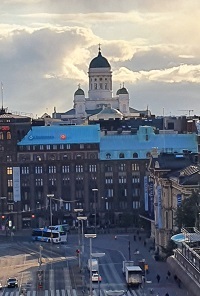Photo. Helsinki - history, culture and traditions.
Happiest city on earth! And one of the safest, cleanest, greenest and the most functional. As you can imagine, it has not always like this, especially for a city like Helsinki that is caught in between wars for centuries. So how did Finns build their beautiful capital city? How did they make it one of the most important cities in the Nordics?
I never stop wondering travelling around the world, and when it come to Finland and Helsinki I really think I need to explore more. Many questions strikes my mind as:
What means Sisu? Why do Helsinki people have picnic on top of graves? How did they build a church inside a giant granite rock? Where did Lenin hide when he was running away from the Tsarist Russia? Why do the Finns love saunas? Why do the Finns swim in ice cold waters? Which statue is the one that seagulls hate the most? Where did they bury thousands of bodies during the plague? Why is the largest Orthodox cathedral located in a Lutheran country?
Helsinki, Swedish Helsingfors, capital of Finland, is the leading seaport and industrial city of the nation. Helsinki lies in the far south of the country, on a peninsula that is surrounded by beautiful natural harbours and that protrudes into the Gulf of Finland. It is the most northerly of continental European capitals. It is often called the “white city of the north” because many of its buildings are constructed of a local light-coloured granite.
Market Square and the surrounding area is a great place to start on your Helsinki adventure early in the morning and in the.night you probably end up working hard with The Three Smiths Statue. It`s is a sculpture by Felix Nylund, situated in the Three Smiths Square at the intersection of Aleksanterinkatu and Mannerheimintie. This realistic statue, unveiled in 1932, depicts three naked smiths hammering on an anvil. Look up for Seagulls here! It seams to me that the don`t like the statue, so carefull so you don`t get hit by their "outputs". You will see the old centre Senate Square, surrounded by beautiful neoclassical buildings such the Government Palace, the University of Helsinki and the Helsinki Cathedral.
Pulsating nightlife in Helsinki: in recent years the nightlife of the Finnish capital has become very dynamic and full of nightclubs and trendy night spots. Old Irish Pub, Zetor, Ølhus: walk on .... Zetor - a spot of the countryside in the middle of Helsinki! Enjoyed a fantastic meal and local beer here among tractors and other agricultural items. The food and drinks menus are full of Finnish spirit: well-known classics and country-inspired specialties. And of course listened and dance to Suomi rokkia.
Sisu has such significance in Finnish culture that it has its own emoji on the Finnish keyboard. Finnish was the first country to develop its own set of emojis, each expressing a unique component of the Finnish experience. As I understand the word it means "guts", also a invisible force that make people achieve "impossible" things. Based of what I know from history and also today the Finns have really guts. To the Finnish people, sisu has a mystical, almost magical meaning. Sisu is a unique Finnish concept. It is a Finnish term that can be roughly translated into English as strength of will, determination, perseverance, and acting rationally in the face of adversity. If you go to Helsinki you will really feel the atmosphere and presence of Sisu by meeting the friendly people there.
I believe the Finns get their sisu from the sauna. Sauna is a strong part of the Finnish lifestyle and we have over 2 million saunas in a land with 5.5 million people. The sauna experience is an integral aspect of Finnish culture and many Finns actually have saunas in their homes or apartment buildings as a way to integrate a daily detox and communal gathering into their routines. Finns have used the sauna to live in, eat, address matters of hygiene, and, most importantly, give birth in an almost sterile environment. Unlike many other, more densely populated places in Europe, the availability of wood needed to build and warm the sauna has never been an issue.
Why do Finns use sauna? For those working in the fields in harsh conditions, the sauna provided welcome relief to wash and soothe aching muscles. These warm wooden rooms could be used at lower temperatures too, and were at the heart of the major events of a Finn's life.
By Webster's definition, a sauna is 1: a Finnish steam bath in which the steam is provided by water thrown on hot stones (löylyä): a bathhouse or room used for such a bath. 2: a dry heat bath: a room or cabinet used for such a bath. By a Finn's definition, it's the place you strip down and go to sweat it out and relax. Why would you ever want to go into an 80°C room to sweat it out you ask? Well, it's hard to explain – you just have to try for yourself! Maybe to will experience the sisu too!
Stein Morten Lund, October 2021












